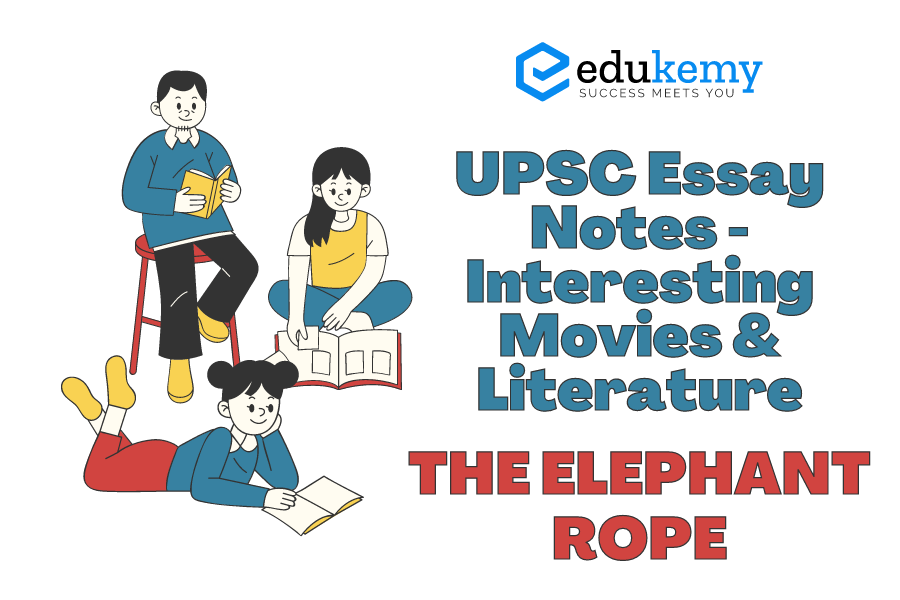
Exploring the intricate tapestry of human experiences, literature and cinema have long served as mirrors reflecting the complexities of our existence. Among the myriad themes they delve into, the notion of overcoming limitations, both self-imposed and societal, stands out as a perennial source of fascination. One such captivating narrative that encapsulates this theme is “The Elephant Rope.” This thought-provoking tale, whether woven through the pages of a book or depicted on the silver screen, challenges conventional perceptions and invites introspection. Through the lens of this story, we embark on a journey that transcends boundaries, inviting us to ponder the nature of limitations and the boundless potential that lies within every individual. In the following essay, we shall delve into the multifaceted layers of “The Elephant Rope,” exploring its relevance, symbolism, and the profound insights it offers into the human condition.
Once a man visited elephant camp, where he noticed something peculiar. The view of gigantic elephants tied to tiny ropes forced him to think about their reasons for captivity. He further thought that they could easily escape the camp since they had all the strength to break free. He then asked one of the employees at the camp as to why those elephants stood still despite all the might they possess. The camp man then said, “when they are noticeably young and much smaller, we use the same size rope to tie them and, at that age, it is enough to hold them. As they grow up, they are conditioned to believe they cannot break away. They believe the rope can still hold them, so they never try to break free.”
Contents
- 1 Frequently Asked Questions (FAQs)
- 1.1 Q: What is “The Elephant Rope”?
- 1.2 Q: How does “The Elephant Rope” relate to UPSC essay preparation?
- 1.3 Q: Can you provide an example of “The Elephant Rope” in literature or cinema?
- 1.4 Q: How can understanding “The Elephant Rope” enhance essay writing skills?
- 1.5 Q: How can I incorporate “The Elephant Rope” into my UPSC essay notes effectively?
- 2 To get free counseling/support on UPSC preparation from expert mentors please call 9773890604
Frequently Asked Questions (FAQs)
Q: What is “The Elephant Rope”?
A: “The Elephant Rope” is a metaphorical concept derived from an ancient tale about elephants. It symbolizes the limitations we place on ourselves based on past experiences or perceived barriers, even when those limitations are no longer relevant or existent.
Q: How does “The Elephant Rope” relate to UPSC essay preparation?
A: Understanding “The Elephant Rope” is crucial for aspirants preparing for the UPSC essay section as it encourages critical thinking and challenges conventional wisdom. It prompts candidates to question assumptions and think outside the box, which is essential for crafting insightful and original essays.
Q: Can you provide an example of “The Elephant Rope” in literature or cinema?
A: Certainly. In literature, the character of Jay Gatsby in F. Scott Fitzgerald’s “The Great Gatsby” can be seen as embodying “The Elephant Rope.” Gatsby is trapped by his past and his unattainable love for Daisy Buchanan, unable to break free from his self-imposed limitations. Similarly, in cinema, the movie “Dead Poets Society” portrays students breaking free from societal and familial expectations, symbolizing the release from the metaphorical ropes that bind them.
Q: How can understanding “The Elephant Rope” enhance essay writing skills?
A: Recognizing and analyzing “The Elephant Rope” in various contexts can help UPSC aspirants develop a more nuanced and insightful approach to essay writing. By acknowledging the limitations we impose on ourselves and society, candidates can explore complex issues from multiple perspectives, leading to more profound and well-rounded essays.
Q: How can I incorporate “The Elephant Rope” into my UPSC essay notes effectively?
A: To incorporate “The Elephant Rope” into your UPSC essay notes, consider adding examples from literature, history, cinema, and current affairs that illustrate the concept. Additionally, jot down your reflections on how breaking free from perceived limitations can lead to personal growth, societal progress, and innovative solutions to contemporary challenges.
To get free counseling/support on UPSC preparation from expert mentors please call 9773890604
- Join our Main Telegram Channel and access PYQs, Current Affairs and UPSC Guidance for free – Edukemy for IAS
- Learn Economy for free- Economy for UPSC
- Mains Answer Writing Practice-Mains Answer Writing
- For UPSC Prelims Resources, Click here

